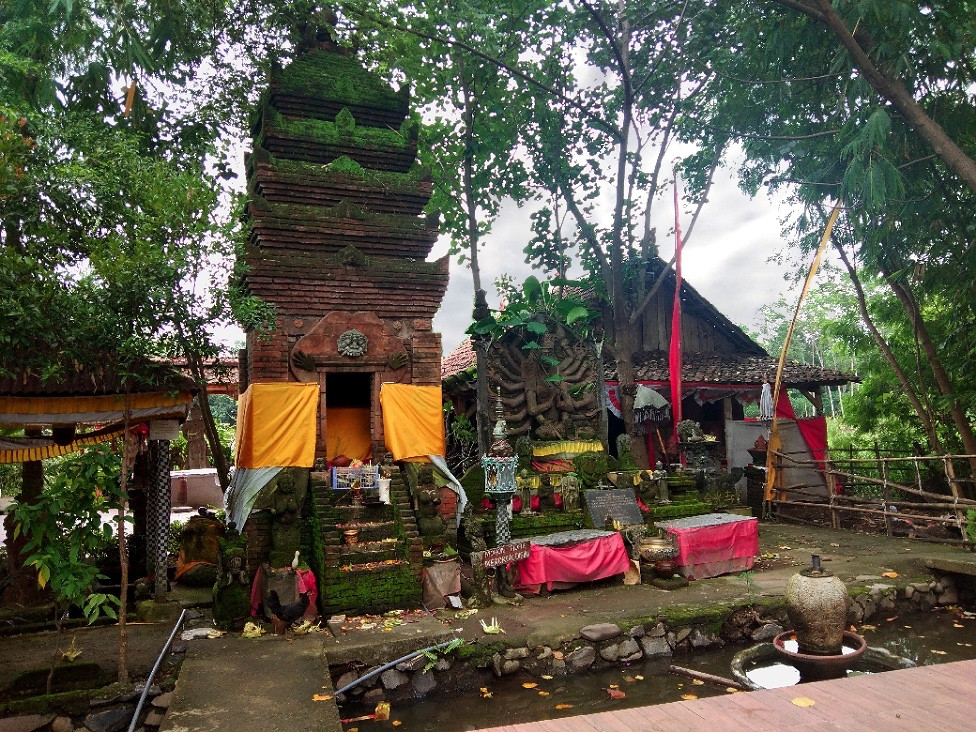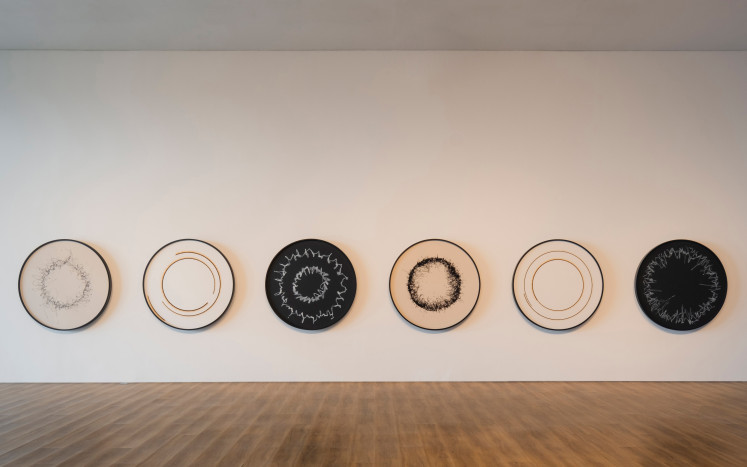Popular Reads
Top Results
Can't find what you're looking for?
View all search resultsPopular Reads
Top Results
Can't find what you're looking for?
View all search resultsPura Kawitan Majapahit: Tribute to an empire that inspires a nation
Pura Kawitan Majapahit pays homage to an empire thought of by many today as the historical antecedent of modern Indonesia, the Majapahit Empire.
Change text size
Gift Premium Articles
to Anyone
Just south of Mojokerto in East Java lies a somewhat peculiar and humble temple complex. Sitting among rice paddies and lily ponds, Pura Kawitan Majapahit pays homage to an empire thought of by many today as the historical antecedent of modern Indonesia, the Majapahit Empire.
Nusantara, a term used by Indonesians today to refer to the Indonesian archipelago, first emerged during the Majapahit Empire, which existed from 1293 until 1520. In 1334, Gadjah Mada, the prime minister widely credited with taking the Majapahit Empire to the height of its glory, proclaimed in the Sumpah Palapa (Palapa Oath) that, until he had unified all of Nusantara, he would not taste palapa, a word historians continue to debate the meaning of, with interpretations ranging from spices to religious rituals. For Gadjah Mada, Nusantara referred to the outer reaches of the archipelago; however, it later came to represent a unifying concept in the sense of Indonesian nationalism that began to emerge during the independence struggle of the early 20th century.
Pura Kawitan Majapahit is located in Trowulan, the former capital of the empire, built at the foot of the imposing Mount Arjuna. The temple complex lies just to the north of the Segeran Pool, a giant rectangular expanse of water bordered by the characteristic red brick of the city that is believed to have once been a recreation spot for the Majapahit royals and their guests.
The pool is one of the few physical remains of the empire’s capital. Nestled among sugar cane fields and rice paddies, these reminders of the past include Candi Bajang Ratu — a temple gateway built to commemorate King Jayanegara after his death — the grand Wringin Lawang gate and the believed burial site of Raden Wijaya, the founder of the empire. According to the caretaker of the site, the presidents of modern Indonesia have made pilgrimages to Raden Wijaya’s grave to pay their respects.
Like the presidents of modern Indonesia, Pura Kawitan Majapahit seeks to honor the nation’s ancestors, and in doing so embodies one of the foundational philosophies of the modern nation, Bhinneka Tunggal Ika (Unity in Diversity), which itself is a quotation from the Javanese poem "Kakawin Sutasoma", written by Mpu Tantular during the Majapahit Empire, that promoted coexistence and unity between Shivaism and Buddhism, the major faiths of the period.
The temple complex was established to “preserve Majapahit customs and culture, without drawing distinctions between religion and ethnicity,” Putu Surya Kertiyasa, the hamengku utama (guardian or caretaker) of the temple complex said, adding that, following the principle of Bhinneka Tunggal Ika, it was a space for Indonesians of all faiths to honor their ancestors.
The complex consists of a series of shrines, statues and other religious objects, placed around a series of ponds. The first of these visitors will see is a shrine dedicated to Shiva, built with red brick in a style reminiscent of the Majapahit temples in Trowulan. Shiva is the deity seen at the center of the Surya Majapahit (Sun of Majapahit), the emblem of the empire, where he is surrounded by the eight other Dewata Nawa Sanga (Guardians of the Directions) arranged in the image of an eight-pointed sun.
Read also: Experts believe wall structure in Mojokerto to be burial site of Ken Arok's descendant
Pura Kawitan Majapahit was founded in 1995 with a ceremony that followed Majapahit customs and rituals, many of which continue to be preserved in Bali. Similar ceremonies are held annually in accordance with the Javanese and Balinese calendars. This year, the ceremony was held over several days from late January into early February.
On regular days, it is common for buses of visitors from Bali to make the journey to the temple complex, as many Balinese trace their ancestry and cultural roots back to the past Hindu-Buddhist civilizations of Java. However, for Putu the complex is “not intended to represent one form of faith alone, instead visitors are free to conduct rituals in the manner they see fit”.
Chinese lanterns and decorations also feature prominently around the complex, an acknowledgment, Putu said, of the way in which Chinese culture had become intertwined with the cultures of the archipelago throughout the centuries.
Perhaps the most intriguing sight within the complex is the pairing of a large Majapahit-style shrine and a Chinese-style pagoda, which stand side by side before a pool of lilies. Putu said that for him personally, the pagoda represented Buddha and was a place to honor his maternal ancestors, while the Majapahit-style temple represented Siva and was a place to honor his paternal ancestors. However, Putu made a point of stating that this was his personal interpretation and that others may find their own meaning.
The complex also houses a large collection of antique kris, the highly ornate daggers that have been produced throughout Indonesia for centuries. The authenticity of the kris has been verified by the Center for Javanese Cultural Institutions (PLKA), with the blades dating back to the Majapahit era and even earlier. Kris hold special importance in many of the cultures of the archipelago and have long been regarded not only as weapons but as spiritual objects. Putu said that members of the community had donated the blades to Pura Kawitan Majapahit so they could continue to be honored in accordance with traditional rituals.
At the center of the complex is a shrine adorned with the Garuda Pancasila, the emblem of modern Indonesia. Featuring Garuda, the mythical eagle ridden by the god Vishnu, clutching a scroll bearing the national motto “Bhinneka Tunggal Ika”, the emblem pays homage to the nation’s past to present a guiding philosophy for the present. With few physical remains of the Majapahit period, Pura Kawitan Majapahit also seeks to carry on the spirit of the empire that centuries after its fall came to inspire the formation of a new nation.











